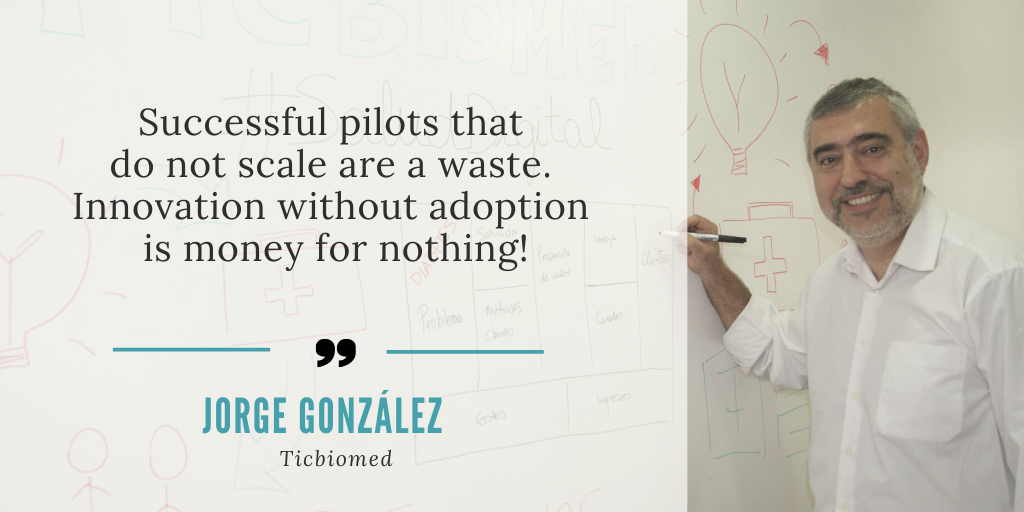nuestra
newsletter
Innovation without adoption is money for nothing

***
Innovation without adoption is, as Dire Straits would say, “money for nothing”. This is one mantra at Ticbiomed, and also one of the biggest challenges we are facing in the digital transformation of healthcare. Successful pilots that do not scale are a waste. A waste of time, resources and opportunities. Even worse, they have a negative impact as they demoralise those involved and make some sceptical about innovation.
I don’t want to sound pessimistic, but let’s be honest: many things need change if we want a to switch from the current ‘death by pilot’ drama to one with a happy ending. Though it seems that in the US the situation is improving, what I perceive in Europe is that we still have many pain points and barriers. Especially when the pilot is co-funded by a public grant from European, national or regional innovation support programmes.
I participated in a project where 5 out of 7 digital health tested pilots were considered successful. How many do you think got adopted (meaning procured)? Only one, and it did not extend beyond the piloting clinical department to the other regional hospitals. Welcome to reality: even if the tested innovation is successful and the end-users love it, there is a high rate of death by pilot. If those that co-created the solution do not procure, who will?
Let me share with you the main facts and recommendations that I have collected after years of attending and moderating events where this was a recurrent topic, as well as facing difficulties when working in several pilots.
6 facts on why adoption is not happening
1. Lack of organizational incentives for healthcare professionals to become the protagonists in innovation. Besides, the “valley of death” of many pilots lets the professionals down because of the lack of implementation.
2. Targeted funding for healthcare organisations to carry out innovation projects is scarce. There are external sources of funding, such as regional structural funds, that can be leveraged to test innovation within healthcare organizations. For example, the demand-driven co-creation approach proposed in the inDemand project.
3. There’s not enough coordination between the agents that intervene in the generation of knowledge or identification of needs, the IT developers and those involved in the adoption of new products. The available funding mechanisms do not encourage coordination among them.
4. Lessons learned and good practices are not systematically shared to favour the culture of innovation within healthcare organizations.
5. The current drive for innovation focuses on attractive pilots that raise a lot of public funding but do not favour adoption. This limits the sustainability of the pilots and makes R&D&i spending inefficient (pilotitis).
6. Without adoption, innovation has no impact.
6 recommendations towards impactful innovation in healthcare
1. Leadership is key; every pilot should have an executive sponsor, ideally at the head of the organisation.
2. Sustainability first; rather than thinking of a pilot and then a potential acquisition, take an ´initial implementation´ approach that considers up-front what the project will look like at scale.
3. Clear rules of the game; jointly define what success means and, more importantly, what happens if pilot objectives are met. Do not postpone this negotiation till the end of the pilot or it likely would not survive the ‘valley of death’.
4. More value, less technology; some pilots are driven by technology (fascination) without having a clear value proposition for the healthcare organisation.
5. Know and engage your users: It is important to get stakeholders (healthcare professionals, management, IT and innovation departments, patients, etc.) involved, aligned and engaged from the very beginning to agree on what they want, and what they want to avoid.
6. Project management excellence; adequate skill-sets and resources (especially time) are critical for success, together with a realistic project plan and timeline, and a clear distribution of roles and responsibilities.
With this full picture in mind, what’s next? In my view, all players in the ecosystem have a part to play. This is certainly a battle that is worth fighting for.
Jorge González. Director at Ticbiomed.
P.S. I want to thank all professionals who have participated in the different events for their outstanding contributions. A special thanks to HIMSS and ITEMAS for giving us a voice in the discussion of innovation and adoption.
Comparte:
